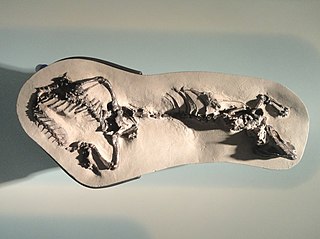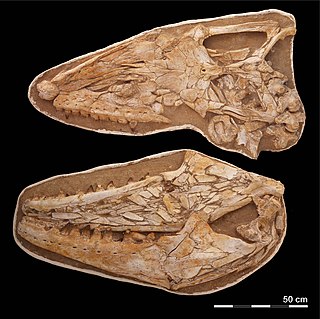
Squamata is the largest order of reptiles, comprising lizards, snakes, and amphisbaenians, which are collectively known as squamates or scaled reptiles. With over 10,900 species, it is also the second-largest order of extant (living) vertebrates, after the perciform fish. Members of the order are distinguished by their skins, which bear horny scales or shields, and must periodically engage in molting. They also possess movable quadrate bones, making possible movement of the upper jaw relative to the neurocranium. This is particularly visible in snakes, which are able to open their mouths very wide to accommodate comparatively large prey. Squamates are the most variably sized living reptiles, ranging from the 16 mm (0.63 in) dwarf gecko to the 6.5 m (21 ft) Reticulated python. The now-extinct mosasaurs reached lengths over 14 m (46 ft).

Amphisbaenia is a group of usually legless squamates, comprising over 200 extant species. Amphisbaenians are characterized by their long bodies, the reduction or loss of the limbs, and rudimentary eyes. As many species have a pink body and scales arranged in rings, they have a superficial resemblance to earthworms. While the genus Bipes retains forelimbs, all other genera are limbless. Although superficially similar to the snakes, legless lizards, and blind lizards, recent phylogenetic studies suggest that they are most closely related to wall lizards of the family Lacertidae. Amphisbaenians are widely distributed, occurring in North America, Europe, Africa, South America, Western Asia and the Caribbean. Most species are less than 6 inches (15 cm) long.

The Maastrichtian is, in the ICS geologic timescale, the latest age of the Late Cretaceous Epoch or Upper Cretaceous Series, the Cretaceous Period or System, and of the Mesozoic Era or Erathem. It spanned the interval from 72.1 to 66 million years ago. The Maastrichtian was preceded by the Campanian and succeeded by the Danian.

The evolution of birds began in the Jurassic Period, with the earliest birds derived from a clade of theropod dinosaurs named Paraves. Birds are categorized as a biological class, Aves. For more than a century, the small theropod dinosaur Archaeopteryx lithographica from the Late Jurassic period was considered to have been the earliest bird. Modern phylogenies place birds in the dinosaur clade Theropoda. According to the current consensus, Aves and a sister group, the order Crocodilia, together are the sole living members of an unranked reptile clade, the Archosauria. Four distinct lineages of bird survived the Cretaceous–Paleogene extinction event 66 million years ago, giving rise to ostriches and relatives (Palaeognathae), ducks and relatives (Anseriformes), ground-living fowl (Galliformes), and "modern birds" (Neoaves).

Palaeosaniwa canadensis is an extinct species of carnivorous lizard from the late Cretaceous of North America. The name, given by Charles Whitney Gilmore in 1928, means "ancient Saniwa from Canada".

Sineoamphisbaena is an extinct genus of squamate of uncertain phylogenetic placement. Its fossils have been found in Late Cretaceous deposits in Inner Mongolia, China. It contains a single species, Sineoamphisbaenia hexatabularis.
This is an overview of the fossil flora and fauna of the Maastrichtian-Danian Hell Creek Formation.
Socognathus is a genus of prehistoric chamopsiid polyglyphanodontian lizards containing species that lived from the Middle Campanian stage to the late Maastrichtian. Several specimens of the type species, Socognathus unicuspis, have been found in Alberta, Canada. A second species, Socognathus brachyodon is known from the late Maastrichtian Lance Formation; its fossils have been found in Wyoming, United States.

Polyglyphanodontia, also known as the Borioteiioidea, is an extinct clade of lizards from the Cretaceous that includes around a dozen genera. Polyglyphanodontians were the dominant group of lizards in North America and Asia during the Late Cretaceous. Most polyglyphanodontians are Late Cretaceous in age, though the oldest one, Kuwajimalla kagaensis, is known from the Early Cretaceous Kuwajima Formation (Japan). Early Cretaceous South American taxon Tijubina, and possibly also Olindalacerta, might also fall within Polyglyphanodontia or be closely allied to the group, but if so, they would be two of only three Gondwanan examples of an otherwise Laurasian clade. They produced a remarkable range of forms. Chamopsiids, including Chamops, were characterized by large, blunt, crushing teeth, and were most likely omnivores. Polyglyphanodon, from the Maastrichtian of Utah, was another herbivore, but its teeth formed a series of transverse blades, similar to those of Trilophosaurus. Peneteius had remarkable, multicusped teeth, similar to those of mammals. The polyglyphanodontids first appear in the latter part of the Early Cretaceous in North America, and became extinct during the Cretaceous-Paleogene extinction event. Polyglyphanodontians closely resembled the teiid lizards, and purported teiid lizards from the Late Cretaceous appear to be polyglyphanodontians. The only species known to have survived the Cretaceous was Chamops, which survived until the very early Ypresian.

Acheroraptor is an extinct genus of dromaeosaurid theropod dinosaur known from the latest Maastrichtian Hell Creek Formation of Montana, United States. It contains a single species, Acheroraptor temertyorum. A. temertyorum is one of the two geologically youngest known species of dromaeosaurids, the other being Dakotaraptor, which is also known from Hell Creek. A basal cousin of Velociraptor, Acheroraptor is known from upper and lower jaw material.
Archaerhineura was a genus of amphisbaenian lizards in the family Rhineuridae that is now extinct. The only species is Archaerhineura mephitis, named in 2015 on the basis of a single fragment of the lower jaw from the Polecat Bench Formation in Park County, Wyoming, which dates to the late Paleocene. Archaerhineura is one of the oldest amphisbaenians and was part of an evolutionary radiation of Rhineuridae in the Paleocene several million years after the Cretaceous–Paleogene extinction event. This rhineurid radiation coincided with the radiation of another group of amphisbaenians, Amphisbaeniformes, which includes the still-extant families Blanidae and Amphisbaenidae. The presence of Archaerhineura and other Paleocene rhineurids in the western United States indicates that amphisbaenians, which would later have a nearly global distribution, originated in North America.
Chthonophis is an extinct genus of amphisbaenian lizard with only one known species, Chthonophis subterraneus, from the earliest Paleocene of northeastern Montana. Chthonophis was named in 2015 on the basis of a partial lower jaw from an outcrop of the Fort Union Formation in the Bug Creek Anthills. The surfaces of the bone are well-rounded, suggesting that the remains had been partially digested by another animal before the jaw had been buried and fossilized. Chthonophis is the oldest known amphisbaenian, yet phylogenetic analysis shows that it was not the most basal. Longrich et al. (2015) classified Chthonophis in its own family, Chthonophidae, finding it to be more derived than Rhineuridae but more basal than other clades such as Blanidae and Amphisbaenidae. The existence of a derived amphisbaenian soon after the Cretaceous-Paleogene extinction event suggests that Amphisbaenia has its origins in the Cretaceous, although no Cretaceous amphisbaenians are currently known. Below is a cladogram from Longrich et al. (2015) showing the phylogenetic relationships of Chthonophis:
Anniealexandria is an extinct genus of amphisbaenian lizard known by the type species Anniealexandria gansi from the earliest Eocene of Wyoming. Anniealexandria is the only known member of the family Bipedidae in the fossil record, which otherwise only includes the extant genus Bipes from Mexico. It was named in 2009 in honor of Annie Montague Alexander, founder of the University of California Museum of Paleontology. Remains of Anniealexandria are known only from a single fossil locality in the Bighorn Basin called Castle Gardens, but within the locality its fossils are common in the Willwood Formation, usually consisting of isolated jaw bones and vertebrae. Anniealexandria seems to have been a common component of a paleofauna that included fifteen other lizard species and existed in western North America during a period of global warming in the latest Paleocene and earliest Eocene.
Odaxosaurus is an extinct genus of anguid lizards that existed in western North America from the Late Cretaceous to the Paleocene. Fossils of the type species Odaxosaurus piger and the species O. priscus are widespread throughout Late Cretaceous formations in the western United States and Canada. First described in 1928 from the Lance Formation in Wyoming, O. piger has since been found in the Hell Creek Formation in Wyoming and Montana, the Frenchman and Scollard formations in Alberta, and the Aguja Formation in Texas. It was one of the few species of lizards to survive the Cretaceous–Paleogene extinction event, which is estimated to have killed off 83% of all lizard species. The second species, O. priscus, was named in 1996 from the Dinosaur Park Formation in Alberta and has since been found in the Kaiparowits Formation in southern Utah. Remains of an anguid from the Kirtland Formation in New Mexico may also belong to Odaxosaurus.
Pariguana is an extinct genus of iguanid lizard from the Late Cretaceous of western North America. It is known from a single type species, Pariguana lancensis, named in 2012 on the basis of a partial lower jaw from the Lance Formation in eastern Wyoming. This jaw bone comes from a layer dated approximately 650,000 years before the Cretaceous–Paleogene extinction event. Pariguana is the oldest definitive iguanid from North America, and may represent the first stage of the iguanian evolutionary radiation from Asia into North America.
Magnuviator is a genus of extinct iguanomorph lizard from the Late Cretaceous of Montana, US. It contains one species, M. ovimonsensis, described in 2017 by DeMar et al. from two specimens that were discovered in the Egg Mountain nesting site. Magnuviator is closest related to the Asian Saichangurvel and Temujinia, which form the group Temujiniidae. Unlike other members of the Iguanomorpha, however, Magnuviator bears a distinct articulating notch on its tibia for the ankle bones, which has traditionally been considered a characteristic of non-iguanomorph lizards. The morphology of its teeth suggests that its diet would have mainly consisted of wasps, like the modern phyrnosomatid iguanians Callisaurus and Urosaurus, although it also shows some adaptations to herbivory.

Coniophis is an extinct genus of snakes from the late Cretaceous period. The type species, Coniophis precedes, was about 7 cm long and had snake-like teeth and body form, with a skull and a largely lizard-like bone structure. It probably ate small vertebrates. The fossil remains of Coniophis were first discovered at the end of the 19th century in the Lance Formation of the US state of Wyoming, and were described in 1892 by Othniel Charles Marsh. For the genus Coniophis, a number of other species have been described. Their affiliation is, however, poorly secured, mostly based on vertebrae descriptions from only a few fossils.

Asteriornis is an extinct genus of bird from the Late Cretaceous of Belgium which is known from a single species, Asteriornis maastrichtensis. It was closely related to birds of the extant superorder Galloanserae such as chickens and ducks. Members of the genus were small, long-legged birds that lived near the coastline and co-existed with more "primitive" types of birds such as Ichthyornis. Asteriornis is one of the oldest-known birds irrefutably belonging to the group Neornithes, which encompasses all modern birds. It possesses characteristics of both galliformes and anseriformes, indicating its position as a close relative of the last common ancestor for both groups.

Thalassotitan is an extinct genus of large mosasaurs that lived during the late Maastrichtian of the Cretaceous period in what is now Morocco, around 66 million years ago. The only known species is T. atrox, described in 2022 from fossils discovered in the Ouled Abdoun Basin, where many other mosasaurs have been found. It was assigned to the tribe Prognathodontini alongside other mosasaurs like Prognathodon and Gnathomortis. The prognathodontines are separated from other mosasaurs based on their massive jaws and robust teeth.











